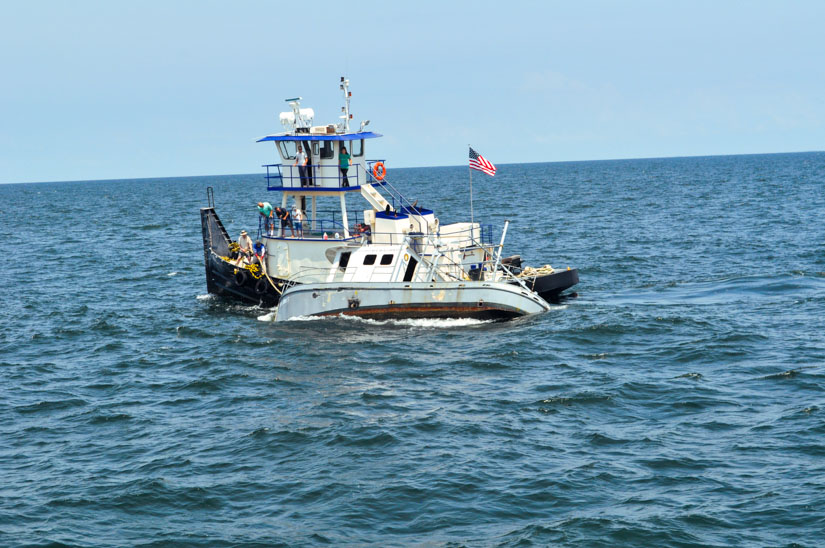Retired USM Research Vessel Transformed into Artificial Reef in Gulf of Mexico
Mon, 05/23/2022 - 01:47pm | By: Van Arnold
 In most instances, the sinking of a ship would be classified as a tragic event. In
the case of the research vessel R/V Hermes, the sinking represented a dignified, memorialized end for a beloved vessel.
In most instances, the sinking of a ship would be classified as a tragic event. In
the case of the research vessel R/V Hermes, the sinking represented a dignified, memorialized end for a beloved vessel.
On Wednesday, May 18 the longtime University of Southern Mississippi (USM) marine trawler was officially transformed into an artificial reef in the Gulf of Mexico during a special ceremony at sea. A tow ship pulled R/V Hermes to a designated spot called Fishing Haven 2, approximately 15 miles south of Horn Island for the ceremonial sinking.
For more than 60 years, R/V Hermes had been used in a variety of capacities by USM’s Gulf Coast Research Laboratory (GCRL), located in Ocean Springs, Miss. Last year, GCRL officially retired Hermes and transferred the vessel to Mississippi Gulf Fishing Banks under the agreement that the group would turn it into an artificial reef.
“With 64 years of service to GCRL, R/V Hermes holds a special place for many associated with the lab,” said Tiffany McNeese, Director of Vessel Operations at GCRL. “The reef deployment was bittersweet to watch, but it has also been an interesting way to memorialize the vessel and her many years of service to Mississippi’s marine laboratory.”
R/V Hermes was a 38-foot, steel-hulled trawler that served as a floating classroom and laboratory, granting students and scientists access to the Gulf of Mexico. A typical day aboard the vessel included trawling for fish, shrimp, and crabs; dolphin watching, and field excursions to Mississippi’s barrier islands.
The number of times R/V Hermes embarked from port is practically impossible to pinpoint.
“No solid records exist, but the vessel likely made a couple thousand voyages in the Gulf of Mexico over the course of 64 years,” said McNeese. “In the final years, it was still at sea anywhere from 30-50 days each summer.”
In preparation for the submersion, pre-drilled holes were covered just above the water line. Once in position, crew members from the tow ship boarded Hermes and removed the covered holes. Water was then pumped into Hermes to add weight. The process took approximately 30 minutes. The vessel’s wheel, bell and plaque have been enshrined onshore.
As she watched the sinking unfold, Dr. Jessie Kastler could not help but reminisce about all the exciting excursions she shared aboard R/V Hermes. Kastler serves as Director of USM’s Marine Education Center and oversees the Summer Field Program.
“Watching Hermes slide into the water made me nostalgic for all the times I have taken teachers and members of the public to explore the coast and islands. Many had never been on the water, so stepping onto the boat took them out of their regular life into a grand adventure. Everybody who went aboard has a story to tell.”
Jill M. Hendon, Director, Center for Fisheries Research and Development, called R/V Hermes “a resounding source of pride for USM,” noting that the vessel acted not only as a platform for research at GCRL but served as a means for thousands of students from around the nation to have their first experience on the open waters of the Gulf.
“USM’s Summer Field Program alumni will remember this vessel as their opportunity to explore a new realm. We are honored to have this vessel provide a unique experience for so many, and we are excited for its future as a reef in the waters she sailed,” said Hendon. “We look forward to continuing to honor R/V Hermes by bringing future Summer Field Program students to this reef where we can educate them on the ecosystem she is establishing below the surface, as well as telling of her history of introducing the Gulf to 64 years of previous students.”
R/V Hermes was named for State Sen. Hermes of Gautier, Miss., who helped then GCRL Director Aubrey Hopkins secure the vessel. The vessel came to GCRL in 1955 after being retrofitted at Kramer Marine in Gulfport.
Joyce M. Shaw, Head Librarian and Professor, GCRL’s Gunter Library, points out that the Summer Field Program students weren’t the only ones being educated during R/V Hermes expeditions.
“Even our local dolphin population learned that most of what a trawl being done to show students the richness of our marine and estuarine species would be thrown back into the water -- so you could always count on having a few dolphins follow R/V Hermes --much to the delight of students,” said Shaw.
USM’s Summer Field Program at GCRL celebrates its 75th anniversary this year. Outdoor classroom experiences through the program continue with USM’s R/Vs Jim Franks and Miss Peetsy B, who will continue to introduce students, educators, and the public to the scientific wonder of the Gulf of Mexico.
To learn more about USM’s Gulf Coast Research Laboratory, call 228.872.4200 or visit: https://www.usm.edu/gulf-coast-research-laboratory/index.php